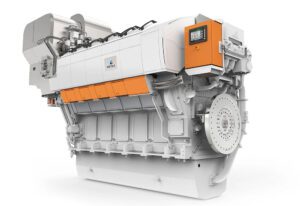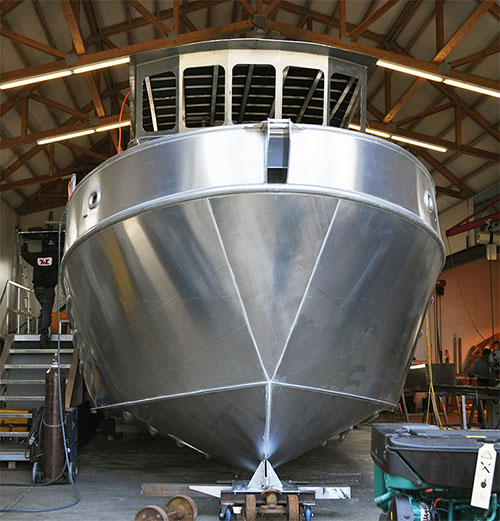
Advances in propulsion options for commercial fishing vessels continue to grow as the industry adapts to changing technologies and new fuel options.
Customers are looking for options that are fully customized to their needs, while meeting regulations and reducing emissions. Some of the most well-known manufacturers continue to blaze the trail of innovation. They include:
Wärtsilä
Wärtsilä offers a complete propulsion line, including engine, gearbox and controllable pitch propellers. The configuration and scope are tailored and defined based on the vessel needs and operating profile. Wärtsilä’s Controllable Pitch (WCP) propeller system is a fully customized combination of a hub, propeller blades, shafting, hydraulics and a control system, as well as further accessories needed to meet customers’ needs.
Maximizing space for fishing, storage and the factory is essential, while ensuring there’s enough power to trawl, transit and run the factory.
“For this, they need to have as much power density in the engines as possible, while reducing the engine room space, through investing in engines which have compact and power dense configurations,” Wärtsilä Norway Senior Sales Manager Pal Rohme explained.
Evolving propulsion technology design has seen the increased use of two speed gears, which enable a vessel to have different modes of operation, but at the same time, keeping an optimum total efficiency in both operational modes and through using a shaft generator. Reducing the use of auxiliary engines and shifting to the shaft generator has significantly reduced fuel burn and emissions, industry insiders have said.
Additionally, through increasing the power of main engines in a more power-dense configuration has been an important advancement. For example, Wärtsilä recently announced that its highly efficient Wärtsilä 31 engine is being upgraded for higher output than ever.

The upgraded version delivers an increased power-to-size ratio within the same physical footprint. In addition to its high efficiency, the engine’s economic fuel consumption results in lower levels of exhaust gas emissions.
What’s ahead for propulsion technology will, of course be region and vessel dependent.
“In recognizing that shipping’s new fuels are not readily available yet at scale, biofuels or low CO2 fuels will see an increase in demand in the short-term,” Wärtsilä Project Manager Nico Höglund told Fishermen’s News. “It’s why we are taking an innovative approach to engine solutions and collaborating with industry partners to transform the industry together.”
“We have seen a lot of success in working with vessel operators to understand the operating modes and profiles of the vessel and the load profiles that will be imposed on the propulsion system,” added Mark Keneford, the company’s general manager of marine sales in the U.S. and Canada.
“We can develop a range of alternatives to show how efficiency is maximized in each operating mode,” he continued. “Also, using the most advanced tools to analyze propellor-to- hull and appendage interaction can result in much reduced fuel consumption.”
MAN Engines
MAN Engines provides compact and high-performance engines, ranging from 400HP to 1450HP, which cater to smaller boats in need of substantial power. These include the inline 6 engine, V8 engine, and a V12 engine with different power ratings.
“On the West Coast fishing side, we see this on the Bristol Bay salmon fishing boats. Sales Manager Jason Blume said. “These are your sprint boats, usually aluminum construction. This is where we really shine.”
MAN continues to be a leader in developing robust Selective Catalytic Reduction (SCR) technology, basing their modular system on the success of similar on-road and off-road truck systems, however, commercial fishing customers are slow on the adoption curve.
Nevertheless, over the next five years, MAN Engines plans to introduce more SCR systems, helping make vessels significantly cleaner as the push for reducing emissions continues. “In many cases, we can take older boats, repower them with our engines, and there is so much flexibility with our SCR system, oftentimes we can make it work in an older boat,” explained Blume. “It does take up some space, but with different configurations and different designs it can be made to work in these boats.”
“We have to get everybody warmed up to use after treatment systems,” MAN Sales Manager Josefine Hollingsworth told Fishermen’s News.
“We already talk to customers about the advantages of using an after-treatment system, especially when it comes to repower,” Hollingsworth said. “On the West Coast, we see more interest in using this latest technology than on the East Coast.”
When it comes to alternative fuels, dual hydrogen-diesel engines are making a splash in Europe, however, according to Hollingsworth, these systems are not yet EPA-certified. Germany has a few certificates for the European market where they have successfully implemented these new systems.
“It reduces CO2 emissions up to 80% when it’s in the most efficient mode,” she commented.
In the U.S., the use of hydrogen depends on needed infrastructure and government support.
“The ultimate goal,” Blume stated, “is to introduce MAN’s customers to electronically controlled engines and gradually introduce them to hybrid options, such as hydrogen or electric-powered systems.”

Volvo Penta
Volvo Penta carries an extensive range of engines and propulsion systems that cater to a wide variety of vessels.
For the commercial fishing fleet, the company has outfitted several, including the 49-foot seiner Royal Fortune, powered by a Volvo D13 700 HP motor, and the 44-foot combination gill-netter/jet boat Highlander, powered by a Twin Volvo D11 engine.
“We are extremely good at engine RPM gear ratio propeller combinations to optimize the driveline for every specific application,” Marine Sales Vice President Jens Bering remarked. “You can have a very efficient engine, but if you don’t have an efficient cooling system, you will lose too much power in the cooling system. It’s really important for all your sub systems, aspiration system and cooling system.”
Volvo Penta’s main focus regarding commercial fishermen is providing cost-effective, in-house-developed SCR systems. Bering highlighted a collaboration with Volvo Truck to develop an in-house marine solution that complies with EPA regulations.
The company focuses on alternate fuel sources such as hydrogen, dual fuel and methanol, with extensive testing underway to explore their viability. Hydrogen is something of a frontrunner, but time will tell, as the infrastructure required to make it readily available is not yet fully developed.
“Commercial fishermen are all about reliability and safety,” Bering told Fishermen’s News. “That’s why we want to bring the appropriate technology and installation to the customer where we can then exercise longevity and uptime and those components. Will hydrogen and methanol be relevant for that community? I can see that.”
Additionally, going electric is another option. For example, fishing vessels can run with conventional diesel out to the fishing grounds, but when idling while pulling nets, switch to battery. In fact, Volvo’s Høvik-based company, ZEM Marine, is at the forefront of this technology, providing 100% electric propulsion systems for Norwegian fishing vessels.
Bering said the use of electric systems for customers in other regions will depend on their specific needs and regulatory landscape.
“For us, it’s about the appropriate technology and what’s right for that customer and their use profile,” he said. “We want to deliver as much as we can to that system, so the operator only has to call one company for his total solution.”
Kathy A. Smith writes for global maritime trade journals and provides marketing copy to maritime businesses worldwide. She can be reached at maritimewriter@gmail.com.
